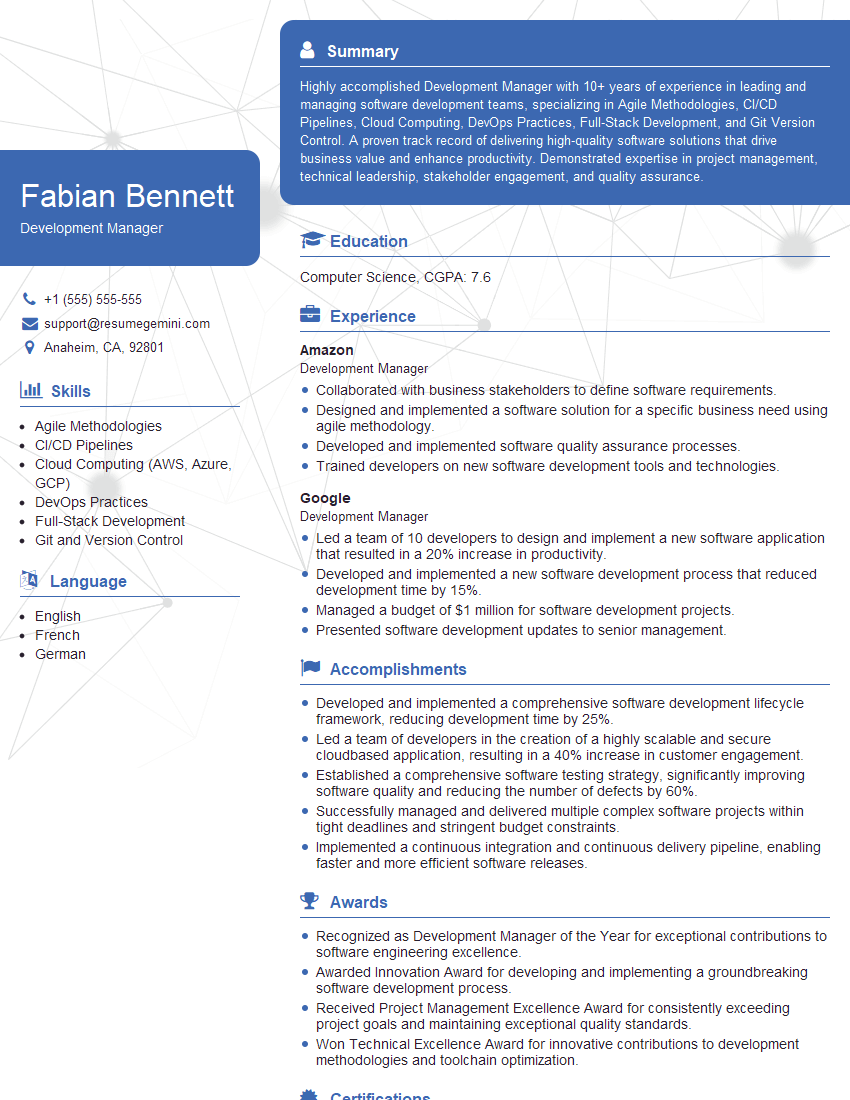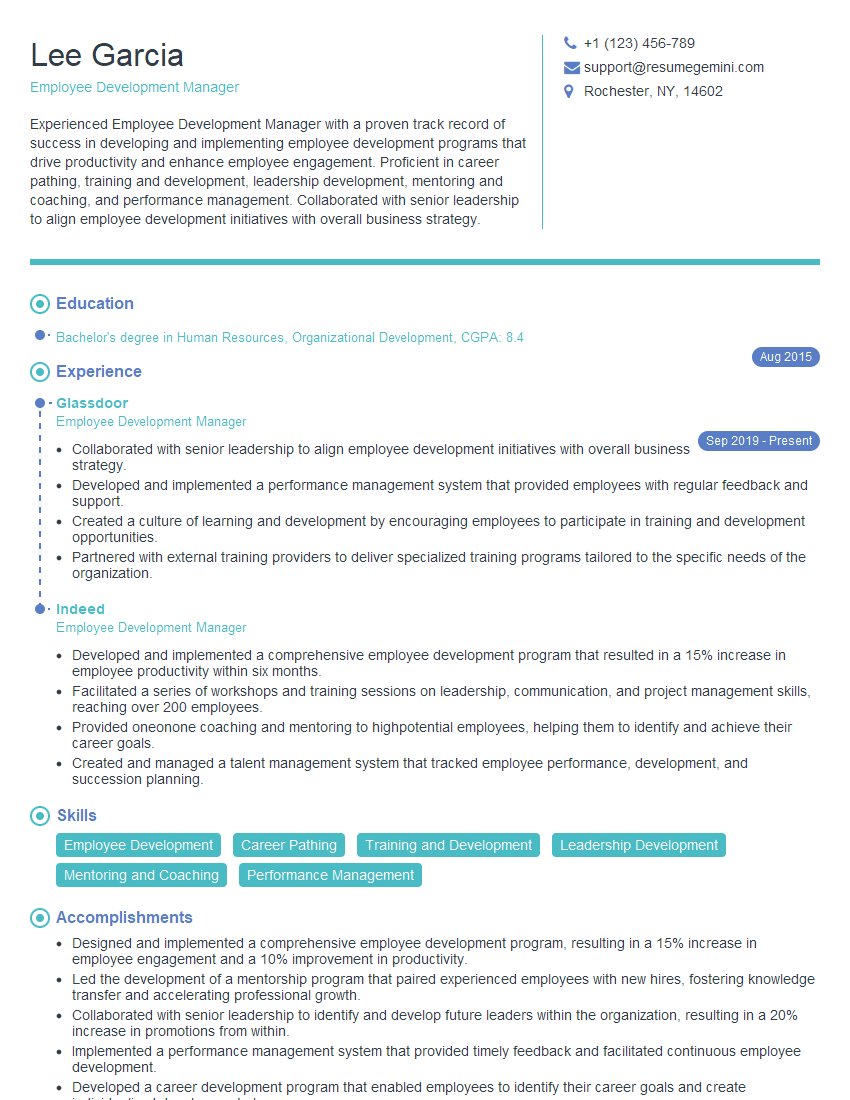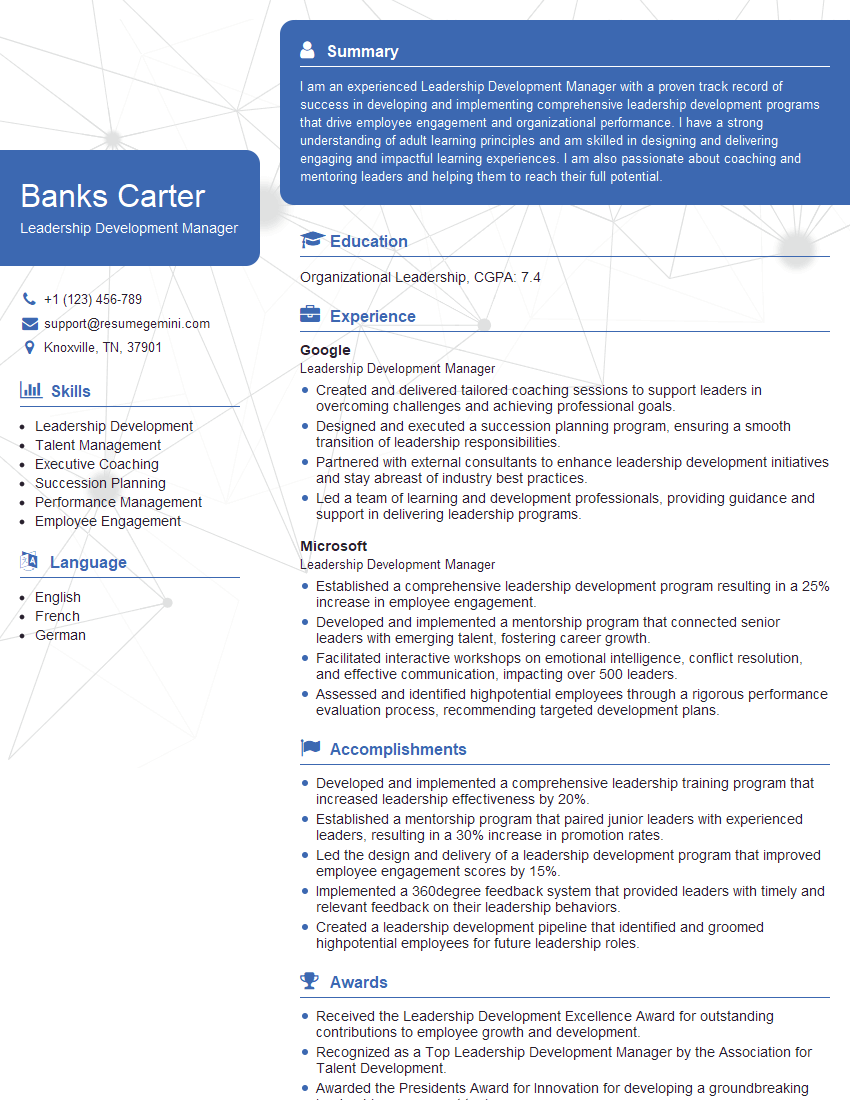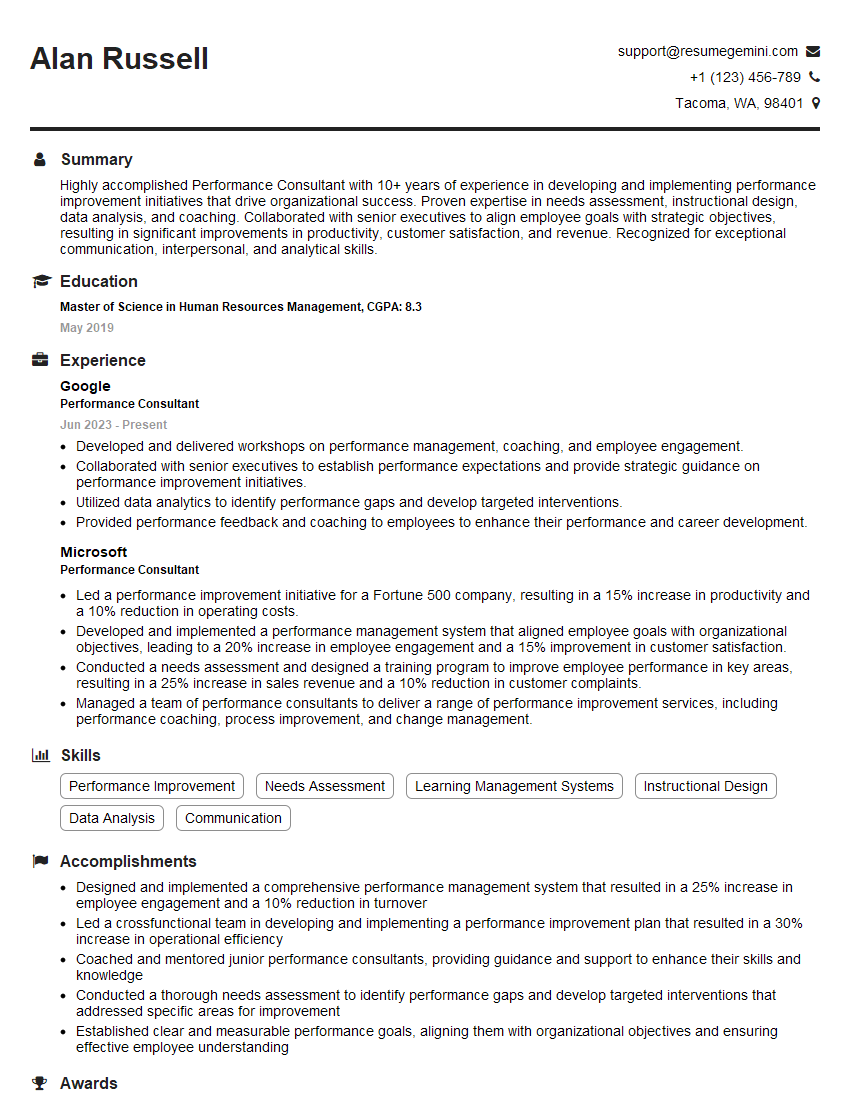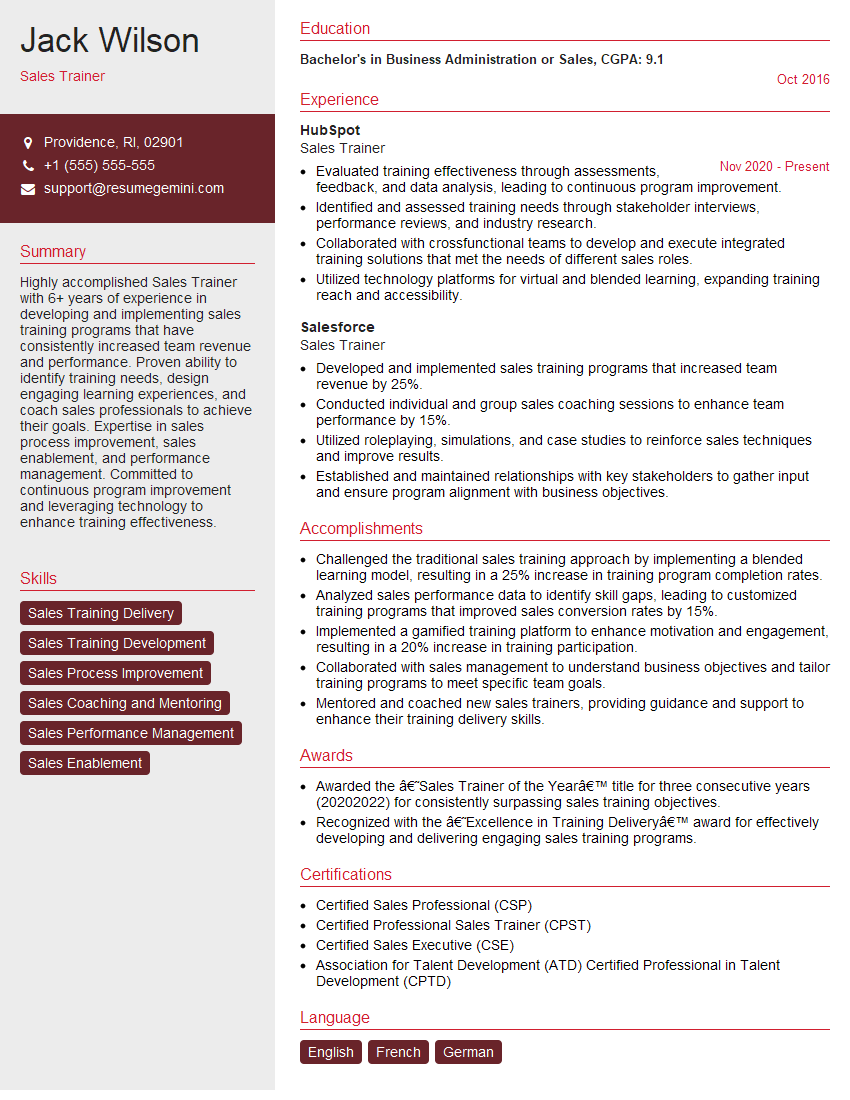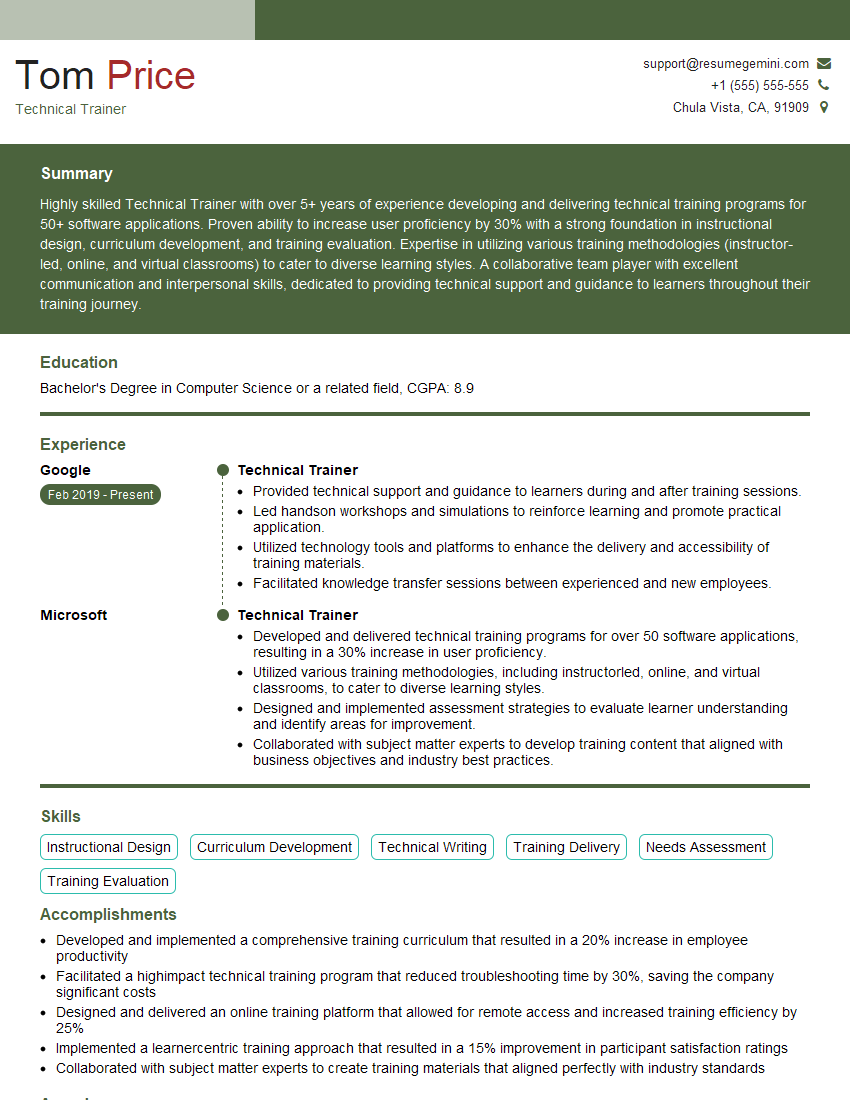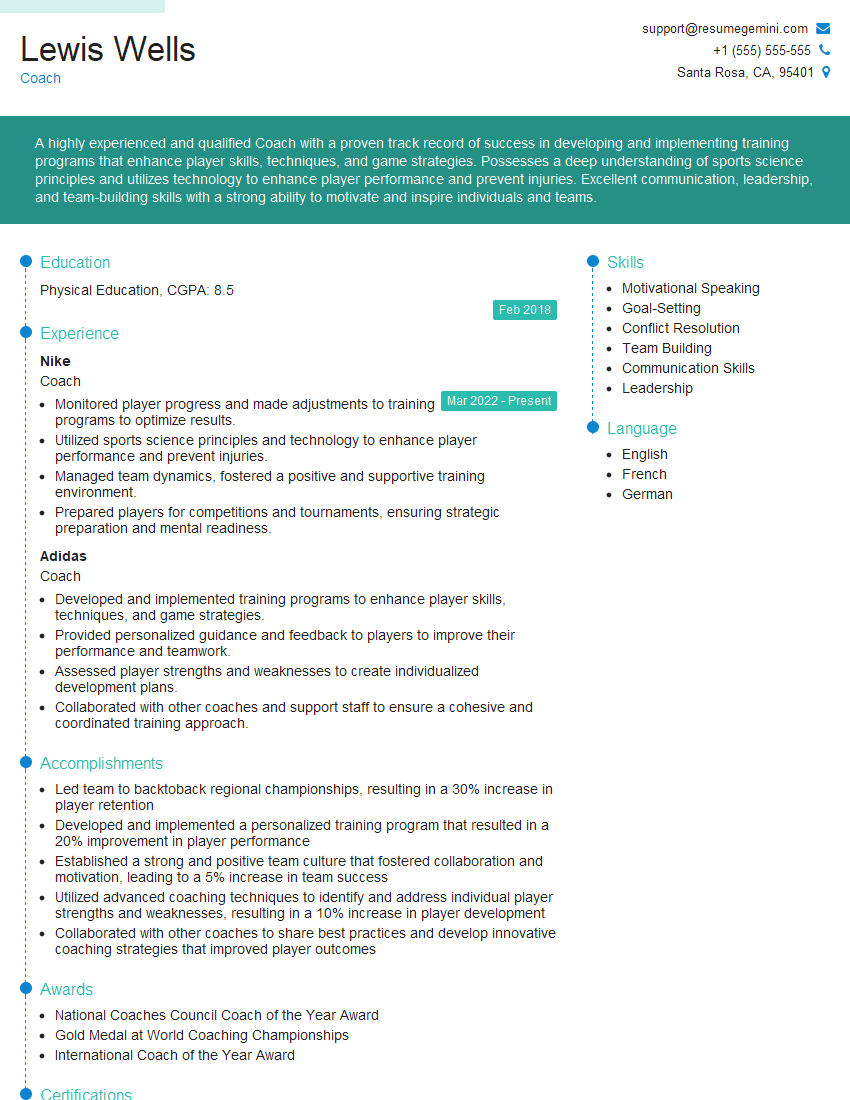Unlock your full potential by mastering the most common Mentoring and Training New Employees interview questions. This blog offers a deep dive into the critical topics, ensuring you’re not only prepared to answer but to excel. With these insights, you’ll approach your interview with clarity and confidence.
Questions Asked in Mentoring and Training New Employees Interview
Q 1. Describe your experience designing and delivering training programs.
Designing and delivering effective training programs requires a systematic approach. I begin by conducting a thorough needs analysis to identify skill gaps and learning objectives. This involves interviews with stakeholders, reviewing existing documentation, and sometimes even conducting job shadowing to understand the day-to-day realities of the role. Once the needs are clearly defined, I design the training program, selecting appropriate methodologies – lectures, hands-on activities, group discussions, simulations, or e-learning modules – based on the learning objectives and the learners’ needs. For example, for a technical role, hands-on labs are crucial, while for a sales role, role-playing might be more effective. The program is then meticulously structured, incorporating clear learning outcomes, assessments, and feedback mechanisms. Finally, I deliver the training, constantly monitoring participant engagement and adapting my approach as needed. Post-training, I often follow up with participants to ensure knowledge retention and application.
For instance, in my previous role, I developed a training program for our new customer service representatives. The needs analysis revealed a need for improved communication skills, product knowledge, and problem-solving abilities. The resulting program included interactive lectures, role-playing scenarios with realistic customer interactions, and online modules for product training. The program’s success was measured by improved customer satisfaction scores and reduced call handling times.
Q 2. What methods do you use to assess the effectiveness of training programs?
Assessing the effectiveness of a training program is critical to ensure its value. I use a multi-faceted approach, combining quantitative and qualitative methods. Quantitative methods include pre- and post-training assessments to measure the knowledge gained. These could be multiple-choice tests, practical exercises, or simulations. I also track key performance indicators (KPIs) after training to assess the impact on job performance. For example, improvements in sales figures, reduction in errors, or increased efficiency are valuable indicators. Qualitative methods involve gathering feedback through surveys, focus groups, or individual interviews to understand participants’ experiences and identify areas for improvement. This helps gauge the program’s impact on attitudes, motivation, and job satisfaction.
In one instance, we measured the effectiveness of a leadership training program by tracking the mentees’ performance reviews six months post-training. We also conducted follow-up interviews to gather feedback on the program’s impact on their leadership styles and confidence levels. This combined approach provided a comprehensive understanding of the program’s success.
Q 3. How do you adapt your training style to different learning styles?
Recognizing that individuals learn in different ways is essential for effective training. I adapt my style by incorporating a variety of teaching methods to cater to visual, auditory, and kinesthetic learners. Visual learners benefit from presentations, diagrams, and videos; auditory learners respond well to lectures, discussions, and audio recordings; while kinesthetic learners learn best through hands-on activities, simulations, and role-playing. I also consider individual learning preferences and pace. Some learners prefer self-paced learning, while others thrive in a group setting. Providing diverse learning materials and opportunities allows for flexible engagement.
For example, when training a team on new software, I provide both a video tutorial and a hands-on workshop. This caters to both visual and kinesthetic learners. I also offer different types of assessments—written tests, practical demonstrations, and even short presentations—to give individuals a chance to showcase their understanding in ways that align with their preferred learning style.
Q 4. Explain your approach to mentoring new employees.
My approach to mentoring is built on a foundation of trust, open communication, and mutual respect. I view mentoring as a collaborative partnership, where I guide and support the mentee’s professional development while valuing their unique perspectives and experiences. My focus is on helping the mentee identify their career goals, develop a plan to achieve those goals, and build the necessary skills and knowledge along the way. This includes providing regular feedback, offering constructive criticism, and celebrating successes. I encourage regular check-ins, creating a safe space for open dialogue and problem-solving. I also act as a sounding board, offering guidance on navigating workplace challenges and fostering their professional growth.
I remember mentoring a junior developer who was struggling with imposter syndrome. By actively listening to their concerns and sharing my own experiences, I helped them build confidence and recognize their strengths. We created a structured development plan that focused on gradually increasing their responsibility and provided opportunities for them to showcase their skills.
Q 5. How do you handle situations where a mentee is struggling to meet expectations?
When a mentee is struggling, my first step is to understand the root cause. This involves open and empathetic conversations to identify any obstacles, be it lack of skills, unclear expectations, personal challenges, or lack of resources. I avoid judgment and focus on providing support. Once the underlying issue is identified, we collaboratively develop a plan of action. This might involve additional training, assigning simpler tasks to build confidence, or connecting them with other resources within the company. Regular check-ins and adjusted expectations are crucial. I believe in providing constructive feedback, focusing on specific areas for improvement rather than general criticism. This approach helps the mentee learn from their mistakes and develop resilience.
For example, I once had a mentee who was struggling to manage their time effectively. After discussing the issue, we developed a plan that included time-management training, setting clear priorities, and breaking down tasks into smaller, manageable chunks. Through consistent check-ins and support, they significantly improved their time management skills and exceeded expectations.
Q 6. Describe a time you had to create a training program from scratch.
I once had to create a training program from scratch for a newly implemented CRM system. The company had just adopted a new system, and there was no existing training material. My approach began with a thorough understanding of the system’s functionalities and the specific needs of different user groups. I interviewed key users to identify their specific challenges and learning preferences. The needs analysis revealed a need for training on different modules, data entry, reporting, and customer management. I then designed the training program, which incorporated a blended learning approach—online modules for self-paced learning and hands-on workshops for practical application. The online modules were short, focused on specific functionalities, and included interactive exercises and quizzes. The hands-on workshops utilized real-world scenarios and allowed ample time for practice and questions. The program’s success was measured by improved user proficiency and increased efficiency in utilizing the CRM system.
Q 7. What are some common challenges you encounter when training new employees?
Several common challenges arise when training new employees. One frequent issue is varying levels of prior experience and knowledge among trainees. This requires differentiating training content and pacing to meet the individual needs of each learner. Another challenge is maintaining engagement throughout the training process. Incorporating interactive elements, practical exercises, and group discussions helps to combat this. A third challenge is ensuring knowledge transfer and application in the workplace. This is addressed through on-the-job training, coaching, mentoring, and follow-up assessments. Finally, managing expectations and addressing anxieties surrounding new roles and responsibilities is crucial. This involves creating a supportive learning environment and building confidence through encouragement and constructive feedback.
Q 8. How do you maintain employee engagement throughout a training program?
Maintaining employee engagement throughout a training program is crucial for successful knowledge transfer and skill development. It’s less about lectures and more about creating a dynamic and interactive learning experience. Think of it like a good story – you want to keep your audience captivated!
- Active Learning Techniques: Instead of passive lectures, incorporate activities like group discussions, case studies, role-playing, and hands-on exercises. For example, if training customer service representatives, role-playing difficult customer scenarios helps trainees apply learned skills in a safe environment.
- Gamification: Introduce elements of game mechanics, such as points, badges, leaderboards, and challenges, to increase motivation and friendly competition. This can be as simple as awarding points for completing modules or achieving specific milestones.
- Regular Feedback and Recognition: Provide consistent feedback on progress, both positive and constructive. Celebrate achievements, both big and small, to boost morale and maintain enthusiasm. Public acknowledgement can be very effective.
- Relevance and Application: Connect training content to real-world situations and the employee’s daily tasks. Show them *why* the training matters to their job and career growth. If training is seen as irrelevant, engagement plummets.
- Flexibility and Choice: Offer varied learning methods (e.g., e-learning modules, workshops, mentoring) to cater to different learning styles and preferences. Some people prefer visual learning, others kinesthetic. Catering to these differences keeps everyone involved.
Q 9. What technologies or tools do you utilize for training and development?
Technology plays a vital role in modern training and development. I utilize a blend of tools to create a comprehensive and engaging learning experience.
- Learning Management Systems (LMS): Platforms like Moodle, Canvas, or TalentLMS allow for centralized course delivery, tracking progress, managing assessments, and providing feedback. They are invaluable for organizing training materials.
- Video Conferencing: Tools like Zoom or Google Meet facilitate live online training sessions, webinars, and virtual mentoring. This allows for real-time interaction and collaboration.
- E-learning Platforms: I use platforms like Articulate Storyline or Adobe Captivate to create interactive e-learning modules with simulations, quizzes, and branching scenarios. This offers flexibility and allows learners to proceed at their own pace.
- Collaboration Tools: Platforms like Microsoft Teams or Slack facilitate communication, file sharing, and teamwork during training projects. These tools are crucial for collaborative learning.
- Performance Support Tools: These tools provide on-the-job support and resources, ensuring trainees can access assistance when needed. Think of job aids, quick reference guides, or online help centers.
Q 10. How do you measure the ROI of a training program?
Measuring the ROI of a training program involves quantifying its impact on the business. It’s not just about attendance; it’s about demonstrable improvements.
- Pre- and Post-Training Assessments: Comparing performance before and after the training helps measure knowledge gained and skill improvement. This could be through tests, surveys, or practical demonstrations.
- Performance Metrics: Track key performance indicators (KPIs) relevant to the training, such as sales figures, customer satisfaction scores, or error rates. Did the training demonstrably impact these numbers?
- Employee Surveys: Gather feedback on the training’s effectiveness, identifying areas for improvement and measuring employee satisfaction. This provides qualitative data to complement quantitative results.
- Return on Investment (ROI) Calculation: A simple ROI calculation is:
(Return - Investment) / Investment * 100%. The ‘return’ could be increased productivity, reduced errors, or improved customer satisfaction, all expressed in monetary terms. - Long-Term Impact: Consider the long-term effects of the training on employee retention, promotion rates, and overall business performance. A well-trained employee is a valuable asset.
Q 11. How do you provide constructive feedback to mentees?
Providing constructive feedback is crucial for growth. It’s about helping mentees identify areas for improvement and develop their skills. I follow a structured approach:
- Be Specific and Timely: Instead of general comments, focus on specific behaviors or actions. Provide feedback as soon as possible after the event.
- Focus on Behavior, Not Personality: Describe the behavior observed and its impact, rather than making judgments about the person’s character.
- Use the SBI Model: This framework helps structure feedback: Situation (describe the context), Behavior (describe the observed behavior), Impact (describe the impact of the behavior). For example: “Situation: During the client presentation, Behavior: you interrupted the client multiple times, Impact: this made the client feel disrespected and potentially damaged the business relationship.”
- Balance Positive and Constructive Feedback: Start with positive points to build confidence and then offer suggestions for improvement. It’s crucial to maintain a positive and encouraging tone.
- Focus on Solutions: Don’t just point out problems; offer suggestions for improvement and resources for further development. Perhaps suggest a relevant training course or provide helpful links.
Q 12. Describe your experience with different training methodologies (e.g., e-learning, blended learning).
I have extensive experience with various training methodologies and tailor my approach to the specific needs of the trainees and the training objectives.
- E-learning: I utilize e-learning platforms to deliver self-paced, interactive modules. This is particularly useful for large groups or geographically dispersed teams. I find incorporating interactive elements like quizzes and simulations keeps learners engaged.
- Blended Learning: This combines online learning with in-person sessions. It leverages the flexibility of e-learning with the benefits of face-to-face interaction and collaborative learning. I often use this for complex topics or those needing hands-on practice.
- Instructor-Led Training (ILT): This traditional approach is effective for interactive discussions, demonstrations, and hands-on activities. It’s great for building rapport and addressing immediate questions.
- On-the-Job Training (OJT): This involves learning by doing under the guidance of an experienced mentor or supervisor. I often integrate OJT into other methodologies, providing practical application of newly acquired knowledge.
- Microlearning: This approach delivers short, focused learning bursts, ideal for busy professionals. It is very effective for delivering quick refreshers or training on specific tasks.
Q 13. How do you foster a supportive learning environment?
Fostering a supportive learning environment is paramount. It’s about creating a space where trainees feel safe, respected, and encouraged to participate actively.
- Establish Clear Expectations: Communicate the learning objectives, assessment methods, and ground rules at the outset. This creates clarity and reduces anxiety.
- Promote Open Communication: Encourage questions, feedback, and open discussions. Create a culture where learners feel comfortable expressing their thoughts and concerns.
- Respect Diverse Learning Styles: Offer a range of learning activities to cater to different preferences. Some learners prefer visual aids, others hands-on activities.
- Provide Mentorship and Peer Support: Pair trainees with mentors or create peer learning groups to provide support and encouragement. Mentorship is extremely effective for personal and professional development.
- Create a Safe Space for Mistakes: Learning involves making mistakes. Create an environment where learners feel safe to experiment, learn from their errors, and ask for help without fear of judgment.
Q 14. How do you handle conflicts between trainees?
Conflicts between trainees can disrupt the learning environment. My approach focuses on mediation and conflict resolution.
- Address Conflicts Promptly: Don’t let conflicts fester. Address them as soon as they arise, ensuring a fair and impartial process.
- Listen to All Sides: Give each party involved an opportunity to share their perspective without interruption. Focus on understanding the issue from different viewpoints.
- Facilitate Communication: Help trainees communicate effectively, focusing on finding common ground and solutions rather than assigning blame. Emphasize collaboration.
- Mediate, Don’t Arbitrate: Guide the parties towards a mutually acceptable solution. Avoid imposing a solution yourself unless absolutely necessary.
- Reinforce Positive Behaviors: After resolving the conflict, reinforce positive behaviors like respect, collaboration, and effective communication. This helps prevent future conflicts.
Q 15. How do you ensure your training programs align with business objectives?
Aligning training programs with business objectives is crucial for maximizing ROI. It’s not enough to simply offer training; it must directly support the company’s strategic goals and contribute to its bottom line. I achieve this alignment through a multi-step process:
Strategic Needs Analysis: I begin by collaborating closely with leadership and department heads to understand the company’s overall strategic plan and identify skill gaps that hinder its achievement. This involves reviewing business plans, performance reports, and conducting interviews to pinpoint areas needing improvement.
Skill Gap Analysis: Once the strategic goals are clear, I conduct a thorough skill gap analysis. This could involve surveys, interviews, performance reviews, or skills assessments to identify the specific skills employees lack to meet those objectives. For example, if the company’s goal is to increase market share by 15%, I would assess whether the sales team possesses the necessary skills in digital marketing and customer relationship management.
Curriculum Design: The training curriculum is then meticulously designed to directly address the identified skill gaps and support the achievement of strategic goals. This ensures that every training module is relevant, purposeful, and contributes to measurable business outcomes. Each module would have clear learning objectives directly linked to business needs.
Evaluation and Measurement: Finally, I implement a robust evaluation system to measure the effectiveness of the training program in achieving its intended business impact. This might involve pre- and post-training assessments, performance tracking, or surveys to gauge employee satisfaction and skill development. This data informs future training initiatives, ensuring continuous improvement and alignment with evolving business goals.
Career Expert Tips:
- Ace those interviews! Prepare effectively by reviewing the Top 50 Most Common Interview Questions on ResumeGemini.
- Navigate your job search with confidence! Explore a wide range of Career Tips on ResumeGemini. Learn about common challenges and recommendations to overcome them.
- Craft the perfect resume! Master the Art of Resume Writing with ResumeGemini’s guide. Showcase your unique qualifications and achievements effectively.
- Don’t miss out on holiday savings! Build your dream resume with ResumeGemini’s ATS optimized templates.
Q 16. What are your strategies for managing training budgets?
Managing a training budget effectively requires a strategic and proactive approach. My strategies include:
Prioritization: I carefully prioritize training initiatives based on their alignment with business objectives and their potential ROI. High-impact training programs that address critical skill gaps are given preference.
Cost-Benefit Analysis: For each training initiative, I conduct a thorough cost-benefit analysis, comparing the cost of the program with the anticipated return in terms of improved employee performance, increased productivity, and reduced errors. This helps justify budget allocations and ensures optimal resource utilization. This might include comparing the cost of external training versus internal training development.
Negotiation and Sourcing: I negotiate favorable contracts with training vendors and explore cost-effective training solutions, such as leveraging online resources, creating internal training materials, or using blended learning approaches (combining online and in-person training).
Continuous Monitoring: Throughout the training process, I closely monitor the budget to ensure adherence to spending limits and identify any potential cost overruns early on. Regular budget reviews help maintain financial control and prevent unexpected expenses.
Innovation: I explore creative and innovative solutions to reduce training costs without compromising quality. This could involve the use of online learning platforms, simulations, or gamification techniques.
Q 17. How do you stay current with best practices in training and development?
Staying current with best practices in training and development is paramount. I achieve this through a combination of:
Professional Development: I actively participate in professional development activities, such as attending conferences, workshops, and webinars related to training and development. This allows me to learn about the latest trends, techniques, and technologies in the field.
Industry Publications and Research: I regularly read industry publications, journals, and research reports to stay abreast of new developments and best practices in training. This keeps my knowledge base up-to-date with the latest pedagogical advancements.
Networking: I network with other training professionals through industry associations and online communities to exchange ideas, share best practices, and learn from the experiences of others.
Online Courses and Certifications: I pursue online courses and certifications to enhance my knowledge and skills in specific areas of training and development, such as instructional design, e-learning, or specific software applications.
Q 18. Describe your experience with performance management systems.
My experience with performance management systems is extensive. I understand that effective training is intrinsically linked to performance management. I’ve worked with various systems, from traditional annual reviews to more agile, continuous feedback mechanisms. My approach focuses on:
Alignment with Training Goals: I ensure that the performance management system is aligned with the training program’s objectives. Performance goals should reflect the skills and knowledge imparted during training, creating a clear connection between training and performance improvement.
Data-Driven Insights: I leverage performance management data to identify areas where training is most needed. Performance reviews, KPIs, and feedback from managers provide valuable insights into individual and team skill gaps.
Feedback Mechanisms: I incorporate robust feedback mechanisms into the performance management system, enabling employees to receive regular feedback on their progress and identify areas for improvement. This feedback loop informs future training needs and strengthens the learning experience.
Performance Improvement Plans: When performance issues arise, I help develop and implement performance improvement plans (PIPs) that incorporate targeted training to address the identified deficiencies. This ensures that training is not just reactive but also proactive in addressing performance challenges.
Q 19. How do you identify the training needs of employees?
Identifying training needs is a crucial step in effective training program design. I use a multi-faceted approach:
Performance Reviews: Regular performance reviews provide insights into individual and team performance, highlighting areas where training could enhance productivity and skill levels.
Surveys and Feedback: Employee surveys and feedback sessions provide valuable information about employee perceptions of their skills, training needs, and areas for improvement. This allows for a more employee-centric approach to training.
Observation and Interviews: Direct observation of employees in their work environments, coupled with individual interviews, can identify skill gaps and areas requiring improvement. This allows for a more holistic understanding of training needs.
Skills Assessments: Standardized skills assessments provide objective data on employee proficiency in specific areas, helping to identify skill gaps that may not be readily apparent through other methods.
Technology Usage: Analyzing the use of technology and software within teams identifies the need for software or technology training.
Business Needs Analysis: Aligning employee skill gaps with business objectives and future needs, ensures training is focused on areas which benefit the whole organization. This is particularly important for emerging trends or technologies.
Q 20. What is your approach to onboarding new hires?
My approach to onboarding new hires is structured and comprehensive, aiming to integrate them seamlessly into the company culture and their roles. It includes:
Pre-boarding: Before the first day, I send new hires welcome packages containing relevant information, such as company policies, organizational charts, and introductions to their team members. This prepares them for their first day and fosters a sense of anticipation.
Orientation: On the first day, I conduct a structured orientation covering company history, mission, values, and culture. This helps new hires understand the company’s context and feel welcomed.
Role-Specific Training: I provide role-specific training to equip new hires with the necessary skills and knowledge to perform their jobs effectively. This training is tailored to the individual role and utilizes a mix of methods, such as online modules, on-the-job training, and mentoring.
Mentorship Program: I establish a mentorship program that pairs new hires with experienced employees who provide guidance, support, and feedback throughout their initial months. This fosters a sense of belonging and helps accelerate their integration into the team.
Regular Check-ins: I conduct regular check-ins with new hires to assess their progress, answer any questions, and provide ongoing support. This ensures they feel supported and addresses any challenges promptly.
30-60-90 Day Plan: I collaborate with the new hire’s manager to establish a 30-60-90 day plan, outlining key goals and milestones. This provides a clear roadmap for success and enables timely feedback and adjustments.
Q 21. How do you use technology to enhance the training experience?
Technology plays a vital role in enhancing the training experience. I utilize various technologies to create engaging, effective, and accessible training programs:
Learning Management Systems (LMS): I leverage LMS platforms to deliver online training courses, track employee progress, and manage training materials. These systems provide a centralized repository for all training resources and allow for personalized learning paths.
E-learning Modules: I develop interactive e-learning modules incorporating multimedia elements such as videos, animations, and simulations to engage learners and make training more enjoyable and effective.
Virtual Reality (VR) and Augmented Reality (AR): Where appropriate, I utilize VR and AR technologies to provide immersive and engaging training experiences. This is particularly useful for hands-on training or complex procedures.
Mobile Learning: I design mobile-friendly training materials to allow employees to access training resources anytime, anywhere. This makes learning more convenient and accessible.
Webinars and Video Conferencing: I use webinars and video conferencing tools to deliver live training sessions, facilitate discussions, and provide remote support. This enables cost-effective and geographically diverse training opportunities.
Gamification: I incorporate game mechanics, such as points, badges, and leaderboards, into training programs to increase engagement and motivation. This makes learning more fun and competitive.
Q 22. How do you ensure that training materials are accessible to all employees?
Ensuring training materials are accessible requires a multifaceted approach that considers diverse learning styles and abilities. It’s not just about making the content available; it’s about making it understandable and usable by everyone.
- Format: I offer materials in various formats – videos, presentations, interactive modules, written guides, and audio recordings. This caters to visual, auditory, and kinesthetic learners. For example, a complex process might be explained through a video demonstration alongside a written checklist.
- Language: Simple, clear language, avoiding jargon, is crucial. I always aim for a reading level appropriate for the target audience. If necessary, I provide translations or multilingual support.
- Accessibility Features: For employees with disabilities, I ensure compliance with accessibility standards (like WCAG). This includes using alt text for images, providing transcripts for videos, using clear font choices, and offering adjustable text size.
- Delivery Method: Materials are made available through various channels – a learning management system (LMS), intranet, or even printed copies, depending on the company’s infrastructure and employee preferences.
- Feedback Mechanisms: I actively solicit feedback on the accessibility of the materials to continuously improve them. A simple survey or informal feedback sessions can be very helpful.
Ultimately, accessibility is about inclusivity – ensuring that every employee has an equal opportunity to learn and grow.
Q 23. Describe your experience with different assessment methods.
My experience with assessment methods is extensive, encompassing a variety of approaches to accurately gauge employee understanding and skill development. I believe in using a blended approach, combining different methods for a comprehensive evaluation.
- Knowledge Checks: I frequently use quizzes and tests to assess knowledge retention after training modules. These can be multiple-choice, short-answer, or even scenario-based questions. For example, after a safety training, a short quiz helps assess their understanding of procedures.
- Performance-Based Assessments: Practical demonstrations or simulations are crucial, especially for skill-based training. This allows me to see how employees apply their knowledge in real-world scenarios. A mechanic, for instance, might be assessed on their ability to diagnose and repair a specific engine problem.
- Observations: Direct observation of on-the-job performance provides valuable insights into employee skill application. This is particularly effective in mentoring situations where I can directly observe their work and provide feedback.
- 360-Degree Feedback: Gathering feedback from peers, supervisors, and subordinates offers a holistic perspective on performance. This is especially valuable for leadership or team-based training, identifying areas of strength and weakness from multiple viewpoints.
- Self-Assessments: I encourage self-reflection through self-assessments, prompting employees to identify their strengths and areas needing improvement. This fosters ownership of their learning journey.
The choice of assessment method depends on the specific training objectives and the nature of the skills being evaluated. It’s important to choose methods that are fair, reliable, and valid.
Q 24. How do you track the progress of mentees?
Tracking mentee progress is an ongoing process requiring a blend of formal and informal methods. Regular check-ins and documented milestones are essential.
- Regular Meetings: Scheduled one-on-one meetings allow for open communication and progress review. I use these sessions to discuss challenges, successes, and adjust goals as needed.
- Goal Setting and Tracking: At the beginning of the mentorship, we collaboratively establish clear, measurable, achievable, relevant, and time-bound (SMART) goals. These goals are then tracked using a simple progress chart or project management tool.
- Documenting Milestones: Significant achievements, skills gained, or challenges overcome are recorded. This provides a clear picture of the mentee’s journey and their development.
- Feedback Mechanisms: I encourage open feedback throughout the mentorship. This includes both formal feedback sessions and informal check-ins. The mentee provides feedback on my guidance as well.
- Performance Reviews: If applicable, formal performance reviews can be incorporated into the progress tracking process.
The key is consistent communication and a collaborative approach. By actively participating in the mentee’s development, I ensure their progress is monitored closely and effectively.
Q 25. What is your experience with creating training materials?
Creating effective training materials is a process that requires careful planning and execution. I start by thoroughly understanding the learning objectives and the target audience. I draw upon my experience with various instructional design models such as ADDIE (Analysis, Design, Development, Implementation, Evaluation) to structure the content.
- Needs Analysis: This initial step involves identifying the knowledge and skill gaps that the training aims to address. I use surveys, interviews, and observations to gather data on these gaps.
- Content Development: Once the needs are identified, I develop the content, drawing upon diverse resources such as industry best practices, subject matter expert input, and existing documentation. I ensure that the content is accurate, up-to-date, and engaging.
- Multimedia Integration: I incorporate various multimedia elements to improve engagement, such as videos, images, interactive exercises, and simulations, tailoring the approach to the subject matter and learner preferences.
- Testing and Revision: The materials are rigorously tested with a pilot group before final deployment. Their feedback is used to revise and improve the materials before wider distribution.
- Delivery Method Considerations: I carefully select the delivery method – online learning platform, in-person workshops, blended learning – ensuring that it aligns with the training objectives and audience preferences.
My experience extends to creating materials for a wide range of subjects, from technical skills to soft skills training, always prioritizing clarity, conciseness, and engagement.
Q 26. How do you deal with resistance to training from employees?
Resistance to training can stem from various sources – fear of change, lack of perceived relevance, or even negative past experiences with training. Addressing this requires a sensitive and proactive approach.
- Understanding the Root Cause: The first step is to understand why the employee is resistant. Open and honest conversations are key to identifying their concerns. Sometimes, it’s simply a matter of scheduling conflicts or workload pressures.
- Demonstrating Relevance: Highlighting the benefits of the training and its relevance to the employee’s job role is crucial. Show how the training will enhance their skills, improve their performance, and potentially lead to career advancement.
- Addressing Concerns: Once concerns are identified, address them directly and transparently. Provide clear and concise answers to their questions. If necessary, provide additional support or resources.
- Personalized Approach: A one-size-fits-all approach seldom works. Tailoring the training to meet individual needs and learning styles can make it more appealing and less daunting.
- Incentivization: Positive reinforcement and incentives can encourage participation and engagement. This could involve offering extra compensation, recognition, or career advancement opportunities.
- Peer Support: If possible, leveraging the support of colleagues who have already benefited from the training can help overcome resistance. Success stories can be highly motivational.
Ultimately, fostering a culture of continuous learning and development is crucial to mitigating resistance. Employees need to see that training is not just an obligation but an opportunity for growth.
Q 27. How do you measure the success of a mentorship program?
Measuring the success of a mentorship program requires a multi-pronged approach, going beyond simply tracking the number of mentees. It involves assessing the impact on both the mentees and the mentors.
- Mentee Development: Track improvements in skills, knowledge, and performance. This could involve reviewing performance appraisals, self-assessments, and feedback from supervisors. For example, did the mentee achieve their set goals? Did their performance improve?
- Career Advancement: Assess the impact on the mentee’s career progression. Did they receive promotions, take on new responsibilities, or increase their compensation?
- Retention Rates: Monitor employee retention rates to see if the mentorship program contributes to reducing employee turnover. This is a key indicator of program effectiveness.
- Mentor Satisfaction: Gather feedback from mentors regarding their experience. Were they satisfied with the process? Did they find it rewarding? This provides valuable insights into program effectiveness and areas for improvement.
- Program Efficiency: Evaluate the program’s efficiency in terms of resources and time spent. Are the resources allocated effectively? Is the program delivering its intended results in a cost-effective manner?
- Qualitative Feedback: Gather qualitative data through interviews, surveys, and focus groups to gain richer insights into the overall impact of the program. This provides valuable context and understanding beyond numbers.
A combination of quantitative and qualitative data provides a comprehensive evaluation of the program’s effectiveness, allowing for continuous improvement and optimization.
Q 28. Describe your experience with developing and implementing a competency model.
Developing and implementing a competency model involves a systematic process of identifying the key skills and knowledge required for successful performance in specific roles or job families within an organization. It’s a strategic tool to align individual development with organizational goals.
- Job Analysis: The process begins with a detailed analysis of each role, identifying the tasks, responsibilities, and required skills. This may involve interviews with job holders, supervisors, and observations of work performance.
- Competency Identification: Based on the job analysis, key competencies are identified. Competencies are typically grouped into categories such as technical skills, interpersonal skills, leadership skills, and problem-solving abilities. These are often expressed as behavioral statements, describing observable actions or behaviors.
- Competency Framework Development: The identified competencies are organized into a framework, often hierarchical in structure, with core competencies and specialized competencies identified. This framework serves as a guide for training, performance appraisal, and career development.
- Validation and Refinement: The competency model is validated through testing and feedback from employees and managers. This iterative process ensures that the model accurately reflects the requirements of the job and the organization’s needs.
- Implementation and Integration: Once validated, the competency model is integrated into various HR processes such as recruitment, training, performance management, and succession planning. This ensures alignment between individual development and organizational goals.
For example, a competency model for sales representatives might include competencies such as ‘client relationship building’, ‘sales presentation skills’, ‘problem-solving’, and ‘product knowledge’. Each competency would then have defined levels of proficiency to guide performance evaluations and training needs.
Key Topics to Learn for Mentoring and Training New Employees Interview
- Onboarding Strategies: Designing effective onboarding programs that integrate new employees seamlessly into the company culture and workflow. Consider practical applications like creating welcome packets, scheduling initial training sessions, and assigning mentors.
- Mentorship Styles and Techniques: Understanding different mentoring approaches (e.g., formal vs. informal, coaching vs. advising) and adapting your style to individual mentee needs. Explore practical application scenarios such as handling challenging mentee behaviors or facilitating productive feedback sessions.
- Training Program Development: Designing and delivering engaging and effective training programs. Consider practical applications such as selecting appropriate training methods (e.g., workshops, online modules, shadowing), assessing training effectiveness, and adapting training based on feedback.
- Performance Management and Feedback: Providing constructive feedback, setting clear expectations, and tracking progress. Explore how to address performance issues effectively and provide support for professional development.
- Learning Styles and Needs: Identifying and catering to diverse learning styles and needs within a group. Practical application might involve tailoring training materials or delivery methods to best suit different learning preferences (visual, auditory, kinesthetic).
- Building Rapport and Trust: Establishing positive working relationships with new employees, creating a supportive environment, and fostering open communication. Explore strategies for building trust and managing conflict effectively within a mentorship relationship.
- Technology and Training: Integrating technology effectively into training programs and staying current with relevant technologies. Practical applications might include using Learning Management Systems (LMS) or incorporating virtual reality (VR) training tools.
Next Steps
Mastering the art of mentoring and training new employees is crucial for career advancement, demonstrating your leadership potential and commitment to organizational growth. A well-crafted resume is your key to unlocking these opportunities. Building an ATS-friendly resume increases your chances of getting noticed by recruiters. We highly recommend using ResumeGemini to craft a compelling and effective resume that highlights your skills and experience in mentoring and training. ResumeGemini offers examples of resumes tailored specifically to roles in Mentoring and Training New Employees, providing valuable guidance and inspiration for your own resume creation.
Explore more articles
Users Rating of Our Blogs
Share Your Experience
We value your feedback! Please rate our content and share your thoughts (optional).
What Readers Say About Our Blog
Hi, I have something for you and recorded a quick Loom video to show the kind of value I can bring to you.
Even if we don’t work together, I’m confident you’ll take away something valuable and learn a few new ideas.
Here’s the link: https://bit.ly/loom-video-daniel
Would love your thoughts after watching!
– Daniel
This was kind of a unique content I found around the specialized skills. Very helpful questions and good detailed answers.
Very Helpful blog, thank you Interviewgemini team.
